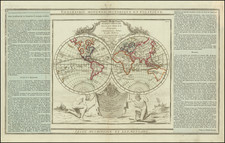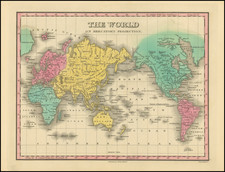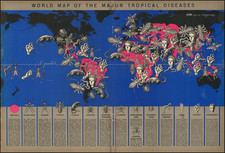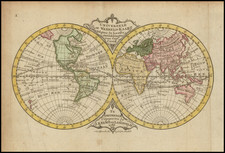A Gorgeous Example of Pieter Goos's Tour-de-Force World Map. Full Original Hand-Color with Gold Highlights.
An exceptional full original hand-color example of Pieter Goos's double-hemisphere map of the World, one of the most sought-after of all Dutch world maps of the 17th century.
In Rodney Shirley's magnum opus, The Mapping of the World, he says of the Goos world map:
Pieter Goos' marine atlases were held to be among the finest printed at the time and were often added to the nine or twelve volumes of Blaeu's Atlas Maior. Goos' general map is of like quality. The two expertly engraved hemispheres geographically follow those by Goos' predecessors Visscher and Blaeu. At the top of the map birds large and small - including a goose - fly in the beams of a resplendent sun. Beneath, a gracefully composed group of figures represents the four seasons: spring, summer, autumn and winter. The map as a whole is particularly well-balanced and pleasing. One of the most decorative world maps to appear in a Dutch atlas.
Goos's rendition of North America follows Blaeu, with a single large Great Lake of indeterminate western extent and California shown as an island.
Provenance
W. Graham Arader III
Thence to the previous owner
Pieter Goos (ca. 1616-1675) was a Dutch map and chart maker, whose father, Abraham Goos (approx. 1590-1643), had already published numerous globes, land and sea maps together with Jodocus Hondius and Johannes Janssonius in Antwerp. Pieter gained recognition due to the publication of sea charts. He bought the copperplates of the famous guide book for sailors, De Lichtende Columne ofte Zeespiegel (Amsterdam 1644, 1649, 1650), from Anthonie Jacobsz. Goos published his own editions of this work in various languages, while adding his own maps. In 1666, he published his De Zee-Atlas ofte Water-Wereld, which is considered one of the best sea atlases of its time. Goos' sea charts came to dominate the Dutch market until the 1670s, when the Van Keulen family came to prominence.












![Western Hemisphere [and] Eastern Hemisphere](https://storage.googleapis.com/raremaps/img/small/77454.jpg)



![De Schepping der Wereldt Volgens de Beschryving van Mozes. 1 Plaat [in set with] De Schepping der Wereldt Volgens de Beschryving van Mozes. 2. Plaat](https://storage.googleapis.com/raremaps/img/small/102641.jpg)